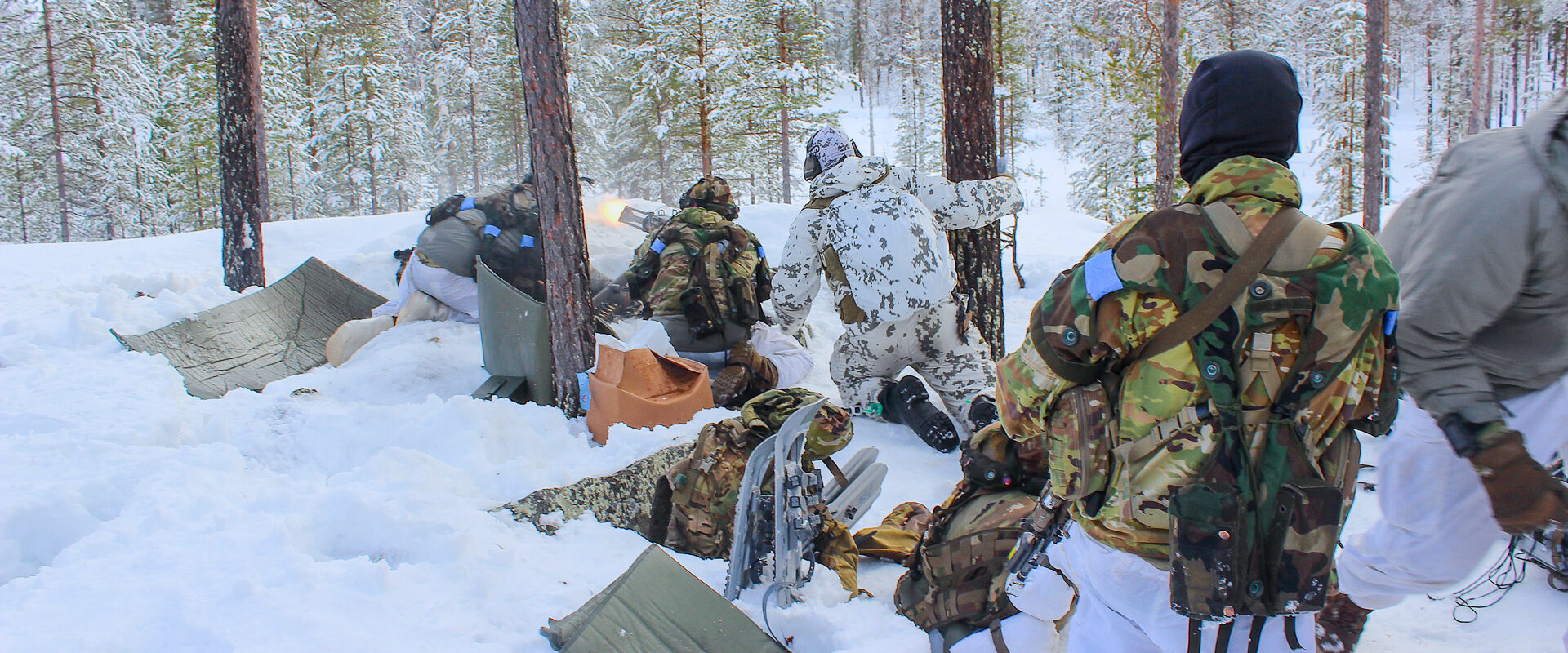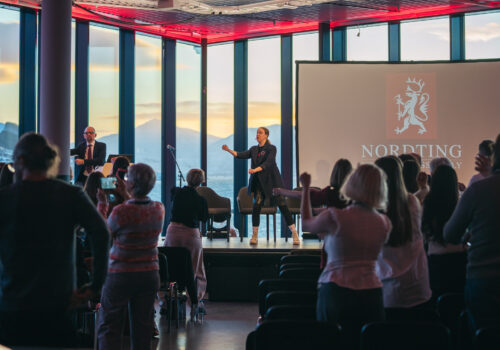SODANKYLÄ, Finland — Machine gun fire cracked through the blanketed stillness, followed by the soft poof of pine needles dropping snow. I ducked instinctively, my knees wet in the snow, behind a cluster of five men burrowed between trees. At our front, near the crest of a ridge, one soldier on his belly angled the thin nose of a Finnish assault rifle slightly downward into the frosted woods. Swinging his weapon rightward, he fired another staccato set of red explosions.
“Go, go, go!” he shouted suddenly, jerking the gun up. The group was instantly in motion: rolling over and half-standing to lift crystal-crusted sacks, weapons and skis out of the heavy wet white.
Somewhere deep in the woods below lurked a “snow leopard”: a white enemy tank rolling through the forest on snow chains. On this late morning in early February, it represented just one ground battle in a 800-square-kilometer war. For the rest of the day, infantry skirmishes continued as a cat-and-mouse game through the Arctic forest.
A week earlier, the Finns had called their American and Canadian allies with an urgent message: They had detected a hostile incursion across their eastern border. The 11th Airborne Division—a US Arctic Army outpost—flew from Alaska over the North Pole to Bardufoss, Norway, where 150 soldiers parachute-landed onto a frozen lake. The 10th Mountain Division flew from upstate New York to Alaska and along to Sodankylä. Over the next several days, more than 300 Americans and 40 Canadians touched down to support their Finnish friends.
Luckily, these guns were firing blanks, not bullets. And this was, in fact, just a simulation: the “Arctic Forge” exercises, a large-scale combat rehearsal that Finland and Norway have hosted since 2021. Assembling around 900 troops from Finland, the United States and, for the first time this year, Canada, they’re practicing the possibility of a high North escalation. This year’s “Arctic Forge 25”—spanning two weeks over both Norway and Finland—was the biggest such simulation yet.
The point isn’t just to practice but also learn from each other. The North Americans might bring the gear and fancy gadgets, but the Nordics know how to fight when it’s freezing. It’s a time-honored tradition dating back to World War II: From Finland’s victory in the 1939 Winter War against the Soviet Union to Norway’s ski-rebels who sabotaged key Nazi facilities, they’ve proven that they can use harsh terrain and weather to their advantage. And their allies—recognizable for their knit beanies, rather than fur-lined caps—are eager to take notes.
“You know you’re in trouble when the snow starts speaking Finnish,” an American soldier quipped as he climbed out of a white-and-sand Bandvagn—a small troop carrier on tracks—paraphrasing an old adage from the Winter War.
Winter warfare
“In this terrain, infantry is the king of the battlefield,” the ice-eyed Finn said in a clipped monotone, standing before a map with a pointer in hand. “In other places, it’s artillery. Not where it’s cold.”
This was Colonel Ari Mure, deputy commander of Finland’s Jaeger Brigade and director of the Sodankylä exercise. I, along with a handful of other journalists, had driven 45 minutes deep into the woods to meet him in a red-roofed bunker and review the week’s plans and progress.
Cold weather combat simply looks different. Standard-issue equipment—from radio systems to oil-based rifle lubricants—often doesn’t work at subzero temperatures, and can also require specific water, wind and ice-resistant designs. Hydraulic-powered artillery and vehicles alike quickly break down, and typical electro-chemical batteries fade faster. In 2023, after a series of breakdowns, the 11th Airborne Division in Alaska replaced its entire fleet of Stryker vehicles with 163 new Cold Weather All-Terrain Vehicles.
It’s a world demanding fur-lined boots and antifreeze. Conditions and terrain rewrite the rules for movement: Soldiers practice shoveling snow to mount their weapons on flat earth and sling rifles on their backs as they ski. And they learn new hazards: Ice-related injuries become likelier; yet for medics, wound treatment often also involves the risk of hypothermia. And everyone must don gear both for warmth and the all-encompassing white.
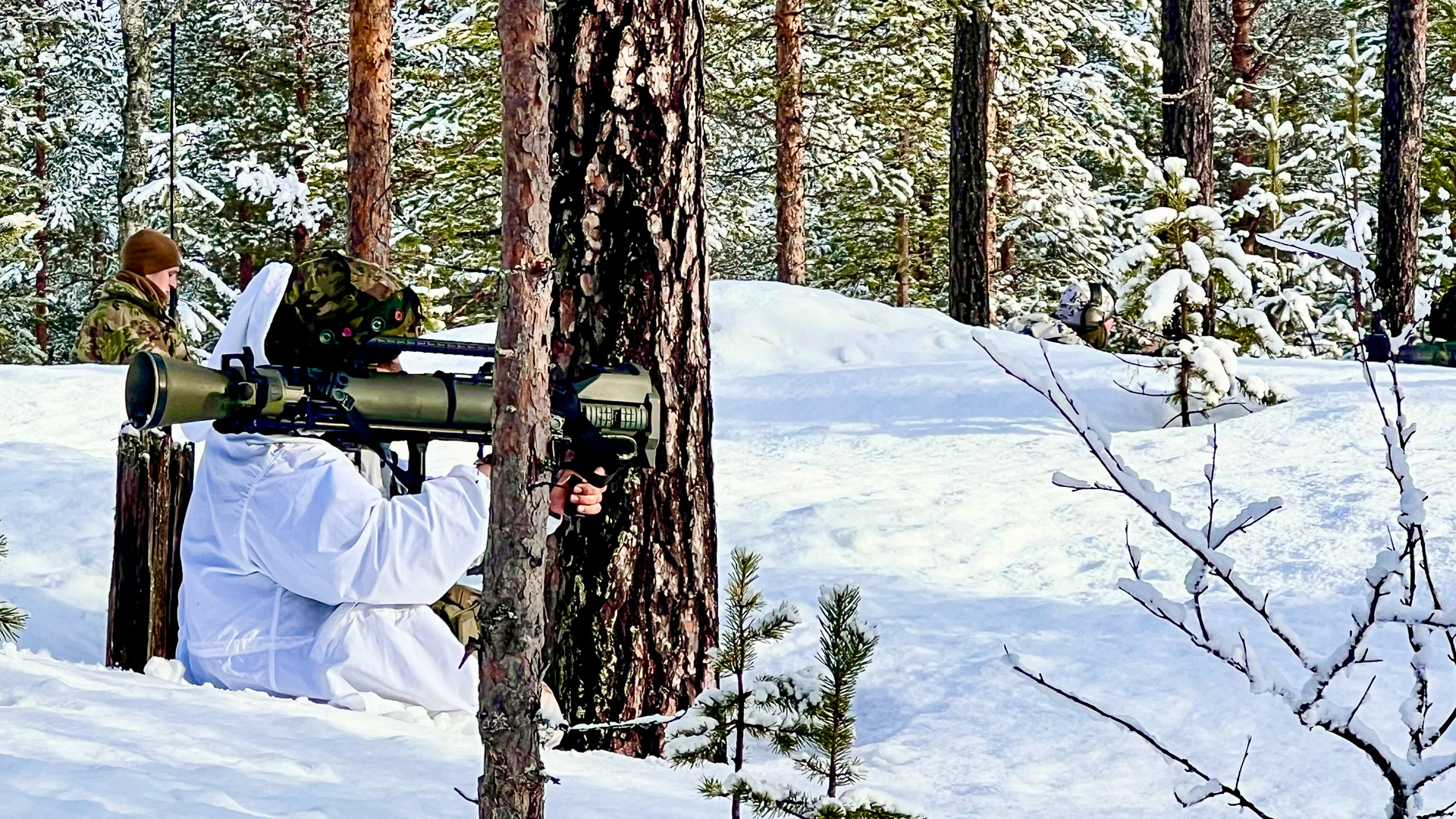
The effect can be visually startling, as if the expected military prototype of green fatigues and tan boots has evolved a high north variant. The sudden sight of a fur-capped Finn, sailing between trees on skis, feels as rare as glimpsing an Arctic fox.
On this relatively temperate day, however, with the sun splitting through trees and sparkling on the snow, the Finns were losing their advantage.
In February, the forests of Sondanklyä should be far below freezing. It’s a tiny Arctic town in a low-slung valley, where icy roads traverse dense, white-robed forests. The kind of place where, in the winter, the ground isn’t merely streaked with snow; it is snow. But today, this snow was different: gummy, heavy and wet. Ski-stopping, sled-slowing. It even smelled wrong: Behind its metallic scent lurked the heavy ferment of wet vegetation. The Finnish Army knows this region well. But the temperatures were stumping them.
“Sometimes the self-confidence can be too high,” Mure said. “But when it’s hot like this, the snow is too heavy and it changes everything.”
High North alliances
For the purposes of this exercise, the eastern enemy was dubbed “The Red Force,” an obvious evocation of the USSR’s Red Army. It wasn’t lost on anyone which country it represented.
Finland shares a border with Russia spanning a whopping 830 miles. And its complicated history is nearly the same length in years. Since 1300, the two nations have had roughly 30 skirmishes and wars. From 1809, the Russian Empire won Finland from Sweden. The Grand Duchy of Finland was an autonomous state until the empire collapsed in 1917. During World War II, the USSR invaded and attempted to seize Finland. Over the Winter War of 1939, outnumbered three-to-one, the Finnish military ingeniously used the cold, dark and home terrain to its advantage, and held onto independence.
But in 1950, when NATO formed as a response to the Soviet Bloc’s Warsaw Pact military alliance, Finland resisted taking a hard stance against its neighbor. For the next 70-plus years, through the Cold War and after, the Nordic state preserved this careful neutrality.
That is, until February 2022. After Russia invaded Ukraine, that calculus abruptly shifted. Almost overnight, Finnish popular opinion swung in overwhelming favor of NATO membership. In May 2022, Finland applied to join the alliance. In April 2023, it was accepted.
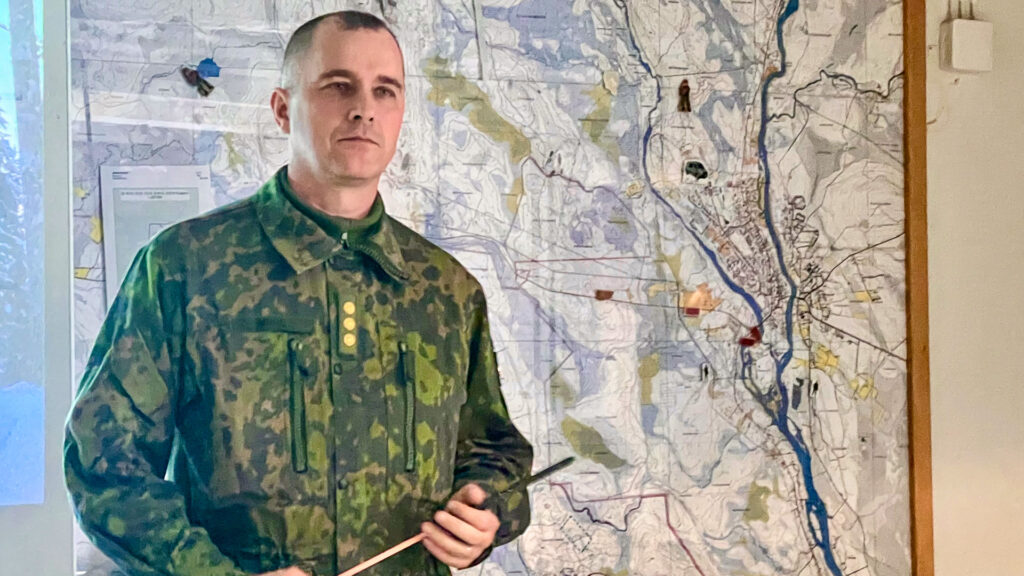
“We have seen major changes since Russia invaded Ukraine, of course,” Mure said, standing outside snow-roofed red wooden bunkers. “The threat became very close and very real.”
Sweden followed a similar trajectory from neutrality to NATO. And with all Nordic states now inside NATO, the Arctic balance of power also shifted. Russia may still comprise half the geographic Arctic, but it is only one of eight Arctic states. Suddenly, with the “Arctic seven” allied militarily, it became the odd one out. For the Nordic nations, such an alliance had been unseen for centuries.
“This is the strongest Nordic alliance since the Kalmar Union,” Michael Paul, senior fellow in security policy at the German Foundation for Science and Politics told me in 2023— referring to a 125-year joint kingdom between Denmark, Norway and Sweden (including much of present-day Finland) that ended more than 500 years ago.
Isolated from other Arctic states, Moscow has welcomed Beijing to the North. For more than a decade, China has called itself a “near-Arctic” state; now it’s offering Russia economic support in exchange for northern sea routes. Their union is increasingly militaristic: In 2023, Russia joined its coast guard with China’s when the two conducted joint exercises in the Bering Strait. In 2024, the United States intercepted Russian and Chinese bomber planes in formation together off the coast of Alaska.
“The increasing competition and militarization in the Arctic region, especially by Russia and China, is worrying,” NATO military committee chief Admiral Rob Bauer said in October 2024 at the Arctic Circle Assembly in Reykjavik, Iceland. “We must be prepared for military conflicts arising in the Arctic.”
An American in Sodankylä
“Honestly, it kinda sucked. Let’s just say it wasn’t Lufthansa,” said a young male 11th Airborne soldier, stamping his feet in the cold next to a white-camo tent, puffing soft plumes of moisture. “Long and cold. Extremely boring.”
A gold crest emblazoned on the shoulder of his green fatigues read “Black Hawk”: the task force that made the three-hour flight over the North Pole before leaping from the plane to the frozen fields below. In the cold interior of a military aircraft, he said, those relatively brief hours go slowly: windowless and jostling, too loud to talk, with little to do but stare straight in front of you and wait to jump.
Others of the 11th Airborne—including his deputy commander, Canadian Brigadier General Robert McBride—made the trek commercially: 30-plus hours of multi-connection travel from Fairbanks to Sodankylä. McBride said he would have preferred the direct flight.
“What’s important is that we’re here, we’re together and learning from each other,” he said. “Interoperability is crucial and this solidifies our bonds as a NATO fighting force.”
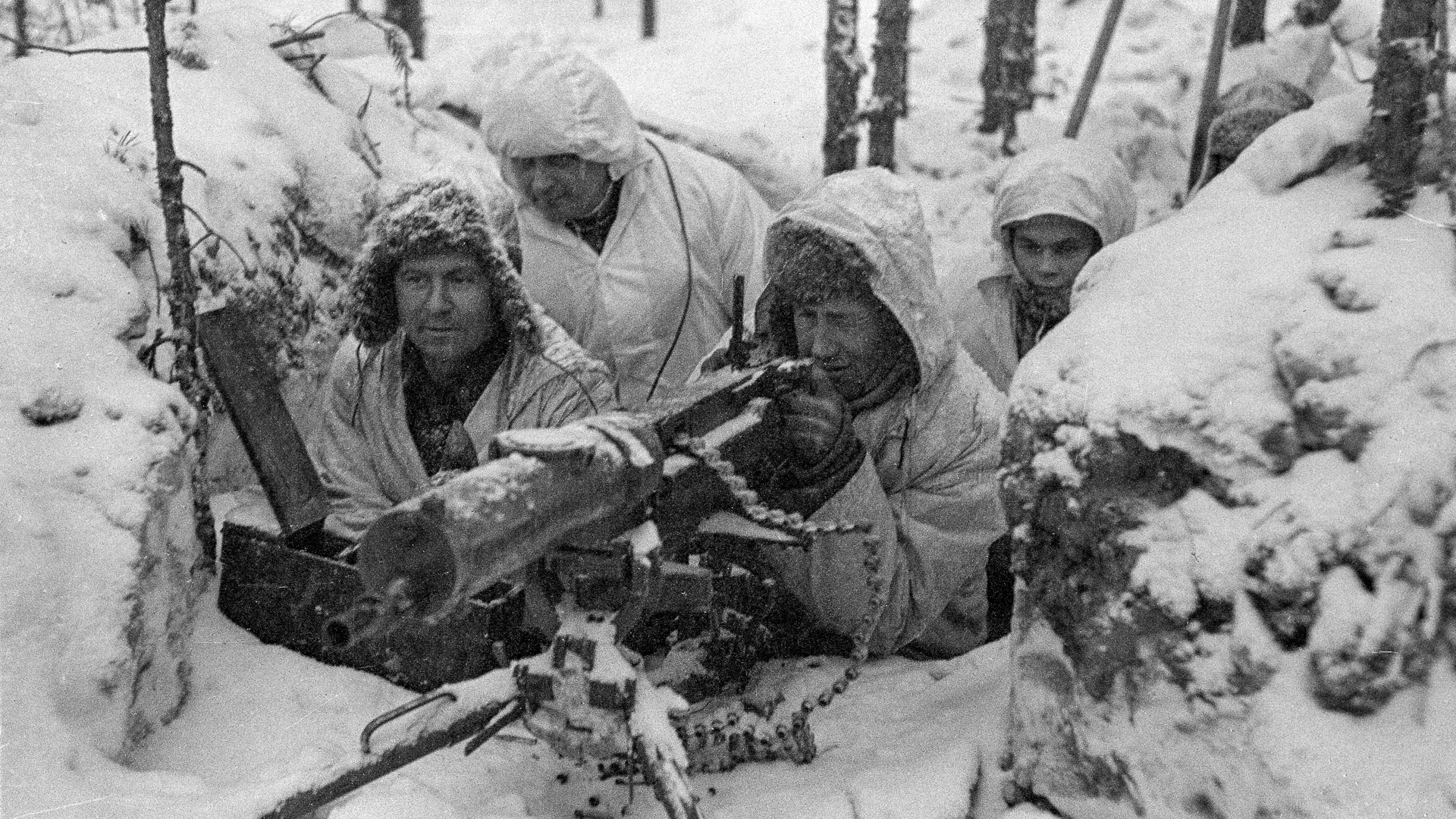
Formed in 1943 in Alaska, the US Army 11th Airborne Division—known as the “Arctic Angels”—started as a fleet of specialized Arctic paratroopers. The Army’s only airborne fleet in the Pacific Theater, it’s famed for liberating the Philippines from Japan during World War II. It was discontinued in 1963.
In 2022, just months after Russia invaded Ukraine, the 11th Airborne came back online. Technically, it was a restructuring: The entire US Army Alaska was absorbed under this singular name. The change, Major General Brian J. Eifler told reporters in 2022, was aimed at “renewing the spirit and purpose of our Alaska-based soldiers by connecting them with this division’s proud and storied history, and better fulfilling America’s role as an Arctic nation.”
In fact, America had started doubling down on Arctic defense nearly a decade earlier. Since 2014, the year Russia annexed Crimea, it has steadily ramped up its Northern Fleet of nuclear submarines, surface ships, missile facilities, air fleets and radar stations.
Today, Russia’s largest military base is on the Kola Peninsula, which borders Norway and Finland, where it is also testing new hypersonic missiles and a nuclear torpedo drone. With the fast-melting Arctic opening new channels for espionage, economic competition and the risk of real combat, the world’s largest military realized it needed to respond in kind. In 2022, the United States opened a new Arctic Office of Global Resilience. That year, with two new Nordic allies, NATO started increasing its high north bases and exercises, too. (I covered this Arctic militarization in 2023 for Foreign Policy Magazine.)
The United States military has been a good ally to have. The Nordics are ramping up their defense spending but their operations still pale in comparison to those of the US Department of Defense (DoD), the single largest government agency in the world. For the Finns, the threat across the border is very real. Much of the geographical line itself is unguarded, and the Finns are, quite practically, no match for Russia, with its defense budget 20 times higher.
But an irony hung over the day. Earlier that morning, over breakfast in the only hotel in town, I caught up on the news from America. Just the day before, President Donald Trump had said that the European Union was “formed to screw over the US.” Finland is an EU member, of course.
This was an organized media day, and as I’ve said, I was there with a handful of other journalists. Prior to climbing into a Bandvagn, the US Army press officers instructed us sternly: No asking the soldiers about politics. The day was focused on collaboration.
So we were left to marvel: In a head-to-head match between our stated ally and Putin’s army, the Americans present couldn’t know for sure for whom our own president would be rooting.
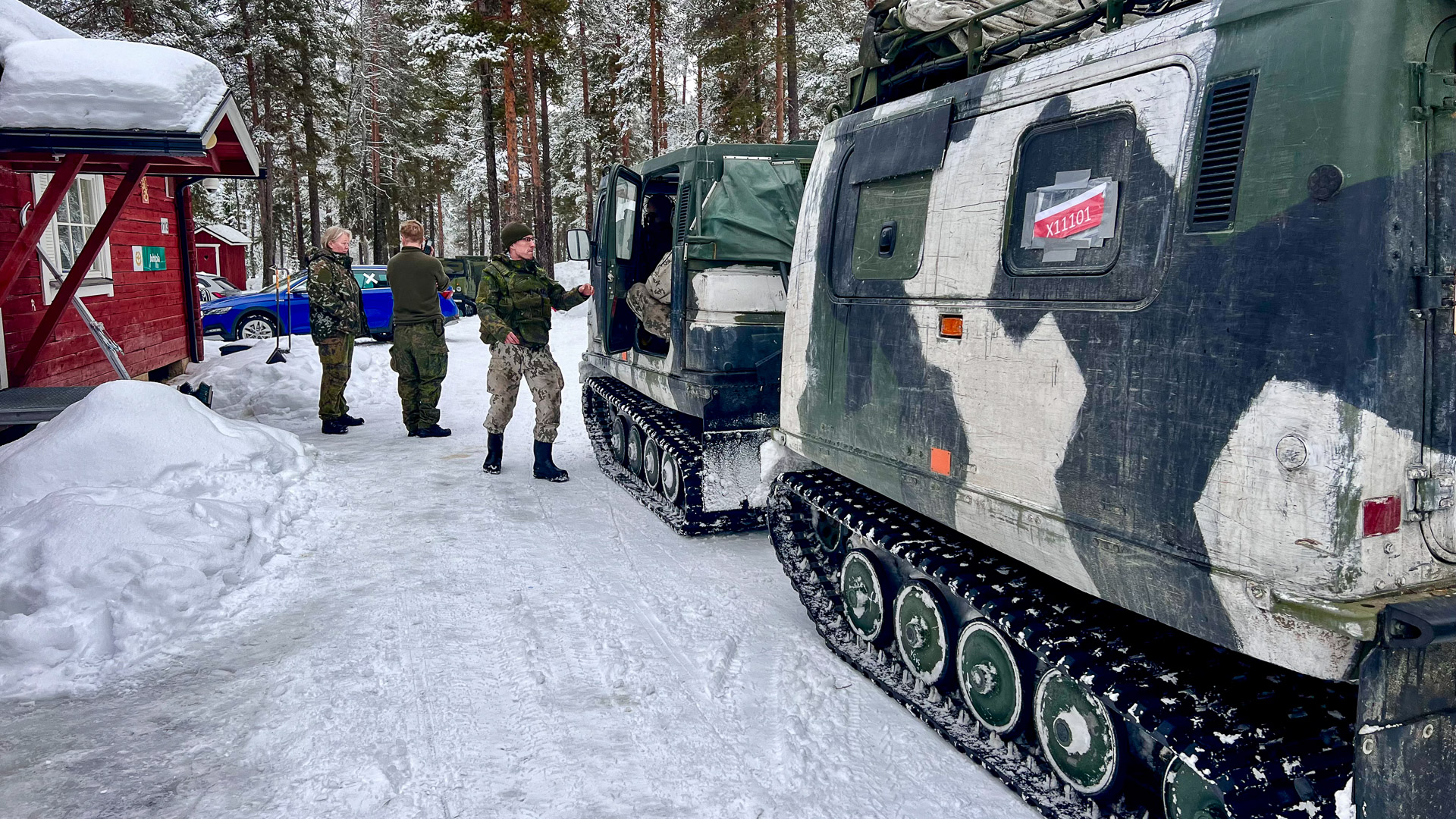
Tensions rising with the temperatures
Later in the afternoon, quick-moving cirrus clouds clustered overhead so that straight pines became pillars between two close frames of white. For hours, fellow journalists and I had been loaded into Bandvagns to trek over terrain between battles. On this fifth day of field combat, the Red Force (played by Finns) was losing ground—and the mood was brightening.
Just as she ducked her head out of a field tent after a strategy meeting, I met American Second Lieutenant Emily Rief, a young soldier hailing from Austin, Texas. She said that after being assigned to Alaska just last year, she went from “never having seen snow” to living in it every day. But, she added, this day was balmy compared to what they’ve had recently in the northern interior.
“Over there, we’ve been getting that 40-below, burn-your-face-off kind of cold,” Rief said. “But this has its own challenges because real cold, at least, is dry.”
After several hours outside, I could feel the wet to my bones: My feet were soaked and my GoreTex gloves could do nothing for my fingertips. The experience of cold is an equation of both temperature and time, and the latter was adding up for me. The Bandvagn offered no respite: As we held onto hanging straps and rolled over the snow, water sloshed between the planks at our feet, and our breath clustered around our faces in fast-fading phantasms. Of course, I couldn’t say anything; I could only marvel at those lying belly-down in shirt-soaking snow, tramping uphill in snowshoes, their numbed fingers pulling triggers. This is a warm day, I kept reminding myself.
That relative warmth speaks to the day’s second contradiction: a climate one. The world’s militaries contribute 5.5 percent of greenhouse gas emissions, and the United States alone makes up two-thirds of that. Up here in the Arctic, which is warming four times faster than the rest of the planet, the environment is particularly vulnerable. Yet here, for the sake of global security, fossil-fuel-powered industrial-grade vehicles were rolling over an otherwise still, relatively undisturbed forest ecology.
In other words, the very exercises intended to adapt to this environment’s cold conditions were, in a way, contributing to its warming. And the same drills intended to improve alliances and increase global security were, from a climate perspective, contributing to making the world more dangerous.
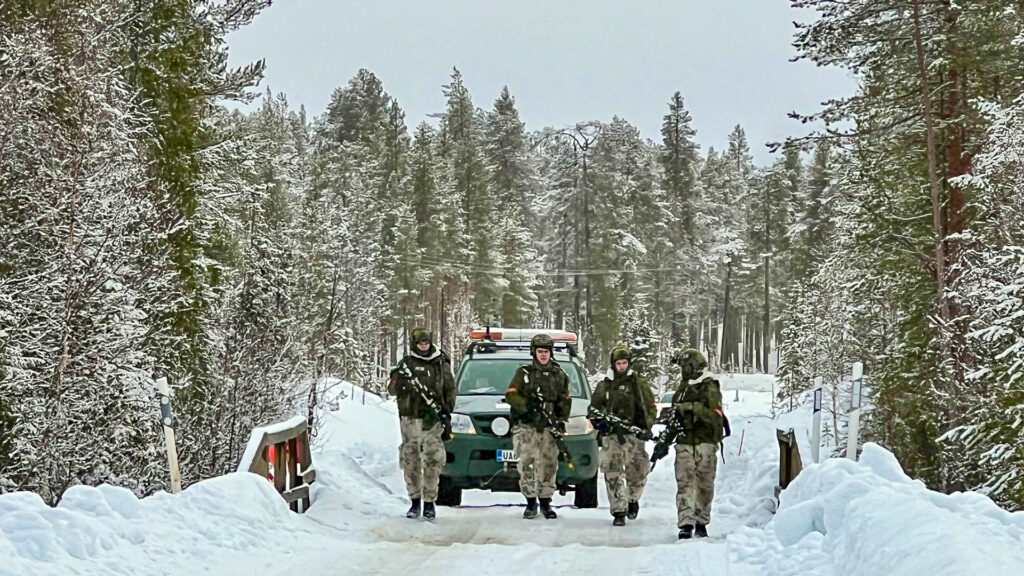
Under President Biden, the American military made an effort to acknowledge and address such contradictions. Beginning in 2021, the US DoD was leading the world in the growing field of “climate security” (as I recently reported for The Atlantic), which involves both adapting to climate and mitigating its own contribution to the crisis through fossil fuels emissions and habitat destruction. Also in 2021, NATO launched its own climate security initiative. Under the current administration, however, that effort is fast unraveling. Within a week of Trump’s taking office, the DoD’s “Climate Resiliency Portal” went offline. In mid-March, commenting on recent cuts to climate research funds, Defense Secretary Pete Hegseth wrote on X that the DoD “does not do climate change crap.”
Writing now in March, this late-February exercise already feels like a relic of a more peaceful past: The US government isn’t just rolling back climate policies; it’s distancing America from its allies. In response, the global order seems to be shifting as quickly as Arctic temperatures.
In early March, Trump cast doubt on whether he would be willing to defend NATO allies at all unless they contribute more funds. “If they don’t pay, I’m not going to defend them,” he said. In a recent administration Signal chat that accidentally included The Atlantic’s Jeffrey Goldberg, Hegseth wrote to Vice President J.D. Vance, “I fully share your loathing of European freeloading… IT’S PATHETIC.”
With an increasingly isolationist US, our northern NATO neighbor is stepping up. In mid-March, Canadian Prime Minister Mark Carney announced a new $4.2 billion Arctic defense package, including a radar system from Australia to detect hypersonic missiles over the North Pole. It will also seriously increase Arctic capabilities, including more exercises like this one. But whether the Canadians would collaborate with US forces is less certain. In late March, Carney commented on Trump’s tariff threats to Canada, saying that the United States was “no longer a reliable partner.”
“The old relationship we had with the United States based on deepening integration of our economies and tight security and military cooperation is over,” he said.
Finnish leaders have made no similar comments. With the Russian threat present and ever-growing, they’re counting on the strength of a 75-year-old alliance they just recently joined, whoever may be leading it. And, given their centuries of history with their much larger and bullying eastern neighbor, they’re well-trained for quietly weathering the darkest and most frigid seasons—and, so far, emerging in relative peace.
Top photo: US and Canadian soldiers fire blanks in a mock battle

